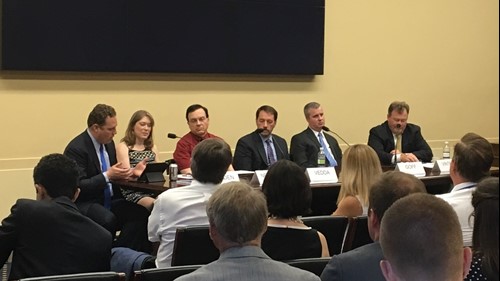Trash in the Skies II: Industry Perspectives on Dealing with Space Debris
Wednesday, July 12, 2017

On Monday, July 10, SWF held a luncheon panel discussion on Capitol Hill that brought together private sector experts to discuss the current space debris situation, what steps are being done (or not done) to address it, whether the blanket 25-year rule is still sufficient, and what role industry can play in helping ensuring the long-term sustainability of space while fostering continued innovation and growth of the space sector. Speakers were from NASA, Aerospace Corporation, OneWeb, Altius Space Machines, and Aon Risk Solutions. The panel's discussion touched on the concern of operators, salvage of debris in space, coordination between megaconstellations, and whether or not the government should be involved in regulating the mitigation of risk in the orbital environment due to space debris.
In 2012, Secure World Foundation (SWF) hosted an event on Capitol Hill called "Trash in the Skies: The Challenge of Space Debris" to discuss the impact the growing amount of space debris has had on space activities. The event highlighted the then estimated 22,000 pieces of space debris larger than a softball that could destroy a satellite in a collision, and the hundreds of thousands of pieces of smaller debris that could cause serious damage. The event also discussed the importance of improving space situational awareness (SSA) for managing the risk posed by space debris, and national and international efforts to mitigate space debris. The biggest effort focused on implementing voluntary space debris mitigation guidelines, the most important of which stipulated that no objects should be left in a protected region for longer than 25 years after the end of their useful life. In addition, the space community needed to focus on developing the capability to start removing space debris from orbit, in order to avoid long-term growth in increased risk over time.
Five years later, there have been few meaningful improvements in the situation. Space debris still continues to pose a threat to space activities. Compliance with the 25-year rule hovers around 40-60%, a rate scientists have concluded is insufficient to stave off long-term growth. Additionally, there have been only very limited efforts made to develop debris removal technologies, particularly in the United States where both NASA and the Department of Defense have shown little willingness to prioritize it. At the same time, the commercial space industry has grown, with dozens of new companies raising billions in private investment to embark on new and innovative uses of space. Several of these companies are planning large constellations of hundreds to thousands of satellites, sparking new concerns about space debris and congestion in space.
More information and event materials, including an audio recording and a transcript in the coming weeks, are available on the event page.

 Share
Share